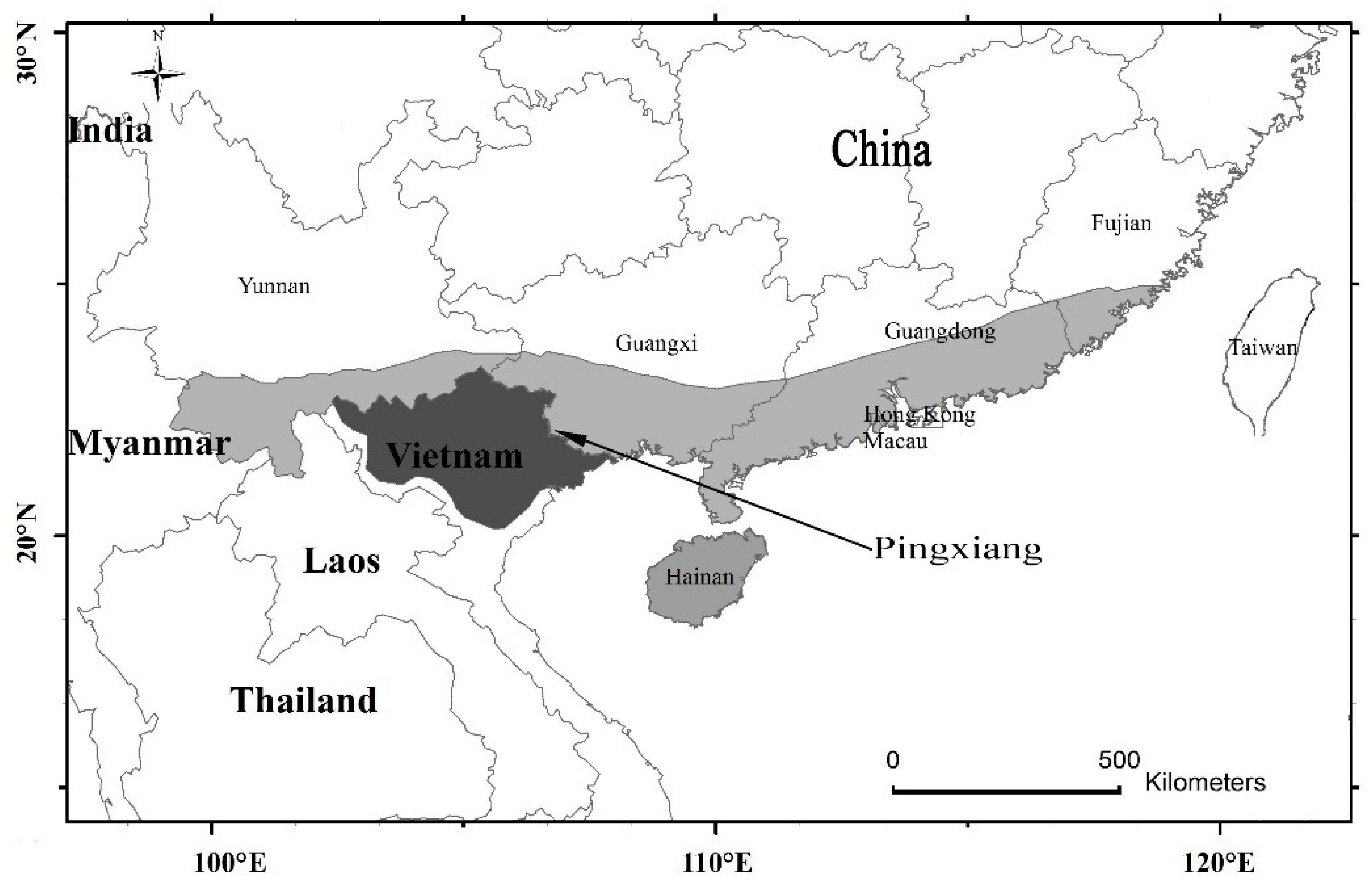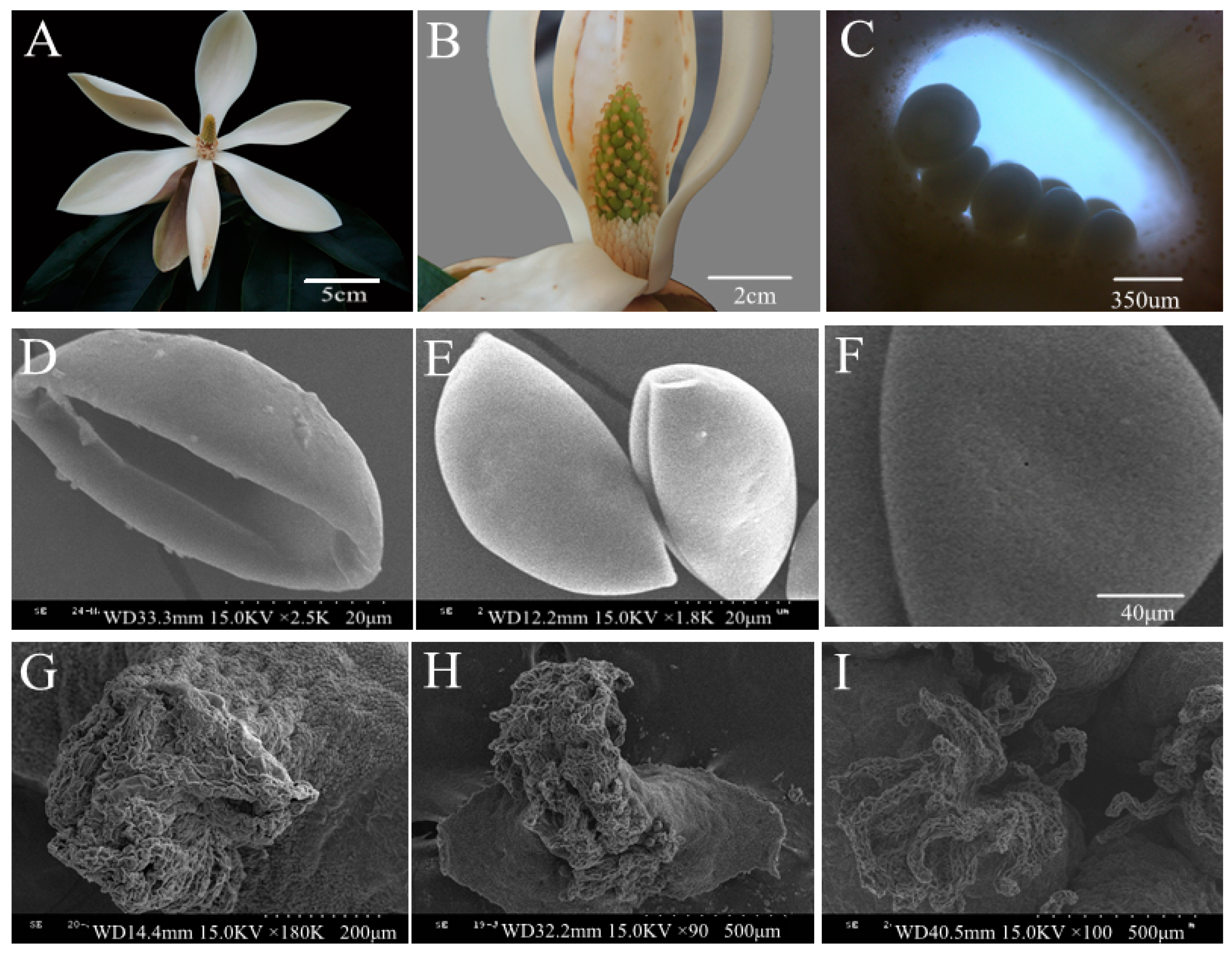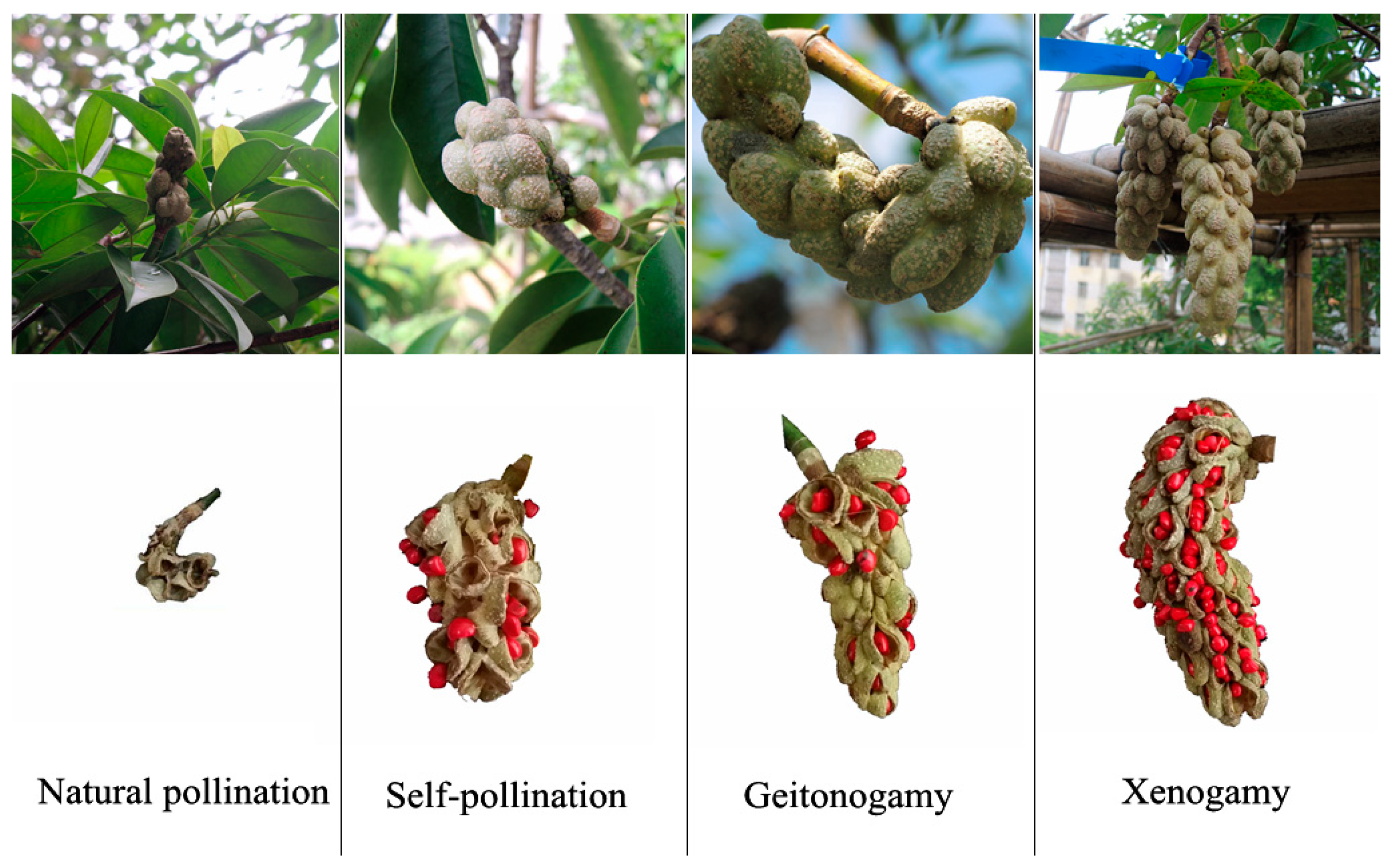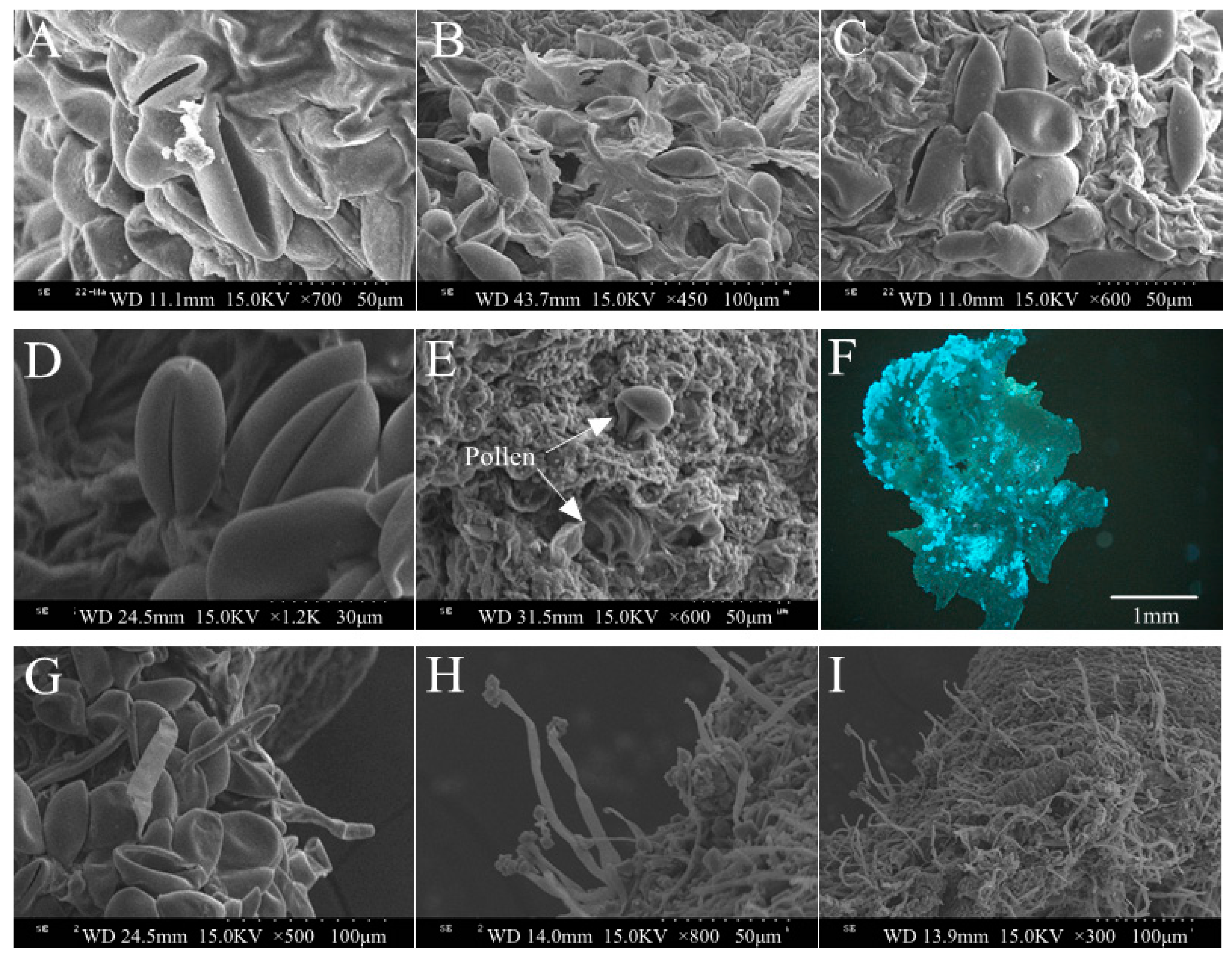Floral Structure and Breeding Systems of Manglietia conifera Dandy (Magnoliaceae)
Abstract
1. Introduction
2. Materials and Methods
2.1. Research Area and Study Materials
2.2. Methods
2.2.1. Flower Structure
2.2.2. Outcrossing Index and Pollen–Ovule Ratio
2.2.3. Controlled Pollination
- Natural pollination (free pollination), non-treatment, testing the fruiting under natural conditions;
- Emasculation before flowering, bagging, and non-pollination, detecting whether the flower has spontaneous apomixis.
- Bagging before flowering, no emasculation and non-pollination, detection of spontaneous self-pollination.
- Emasculation before flowering, no bagging and non-pollination, checking whether the fruiting is restricted by the pollinator.
- Xenogamy, emasculation before flowering, bagging, artificial cross-pollination with pollens from different plants, testing the compatibility of cross-sex.
- Geitonogamy, emasculation before flowering, bagging, artificial cross-pollination with pollens from different flowers on the same plant, detecting whether the same plant can be fertilized.
- Self-pollination, bagging before flowering, artificial self-pollination with pollens from the same flower, testing whether self-fertilization can be viable.
3. Results
3.1. Flower Structure
3.2. Outcrossing Index and Pollen–Ovule Ratio in M. conifera
3.3. Controlled Pollination in M. Conifera
4. Discussion
5. Conclusions
Author Contributions
Funding
Acknowledgments
Conflicts of Interest
References
- Pham, H. Manglietia Conifera, Flora of Vietnam; Minh, H.C., Ed.; Young Publishing House Press: Ho Chi Minh, Vietnam, 2008; p. 50. [Google Scholar]
- Wei, S.H.; Qin, J.; Zhu, X.L.; Qin, W.M.; Deng, L.; Zhang, L.Q. Growth Regularity of Manglietia glauce Plantation Growing in Nanning. J. Northwest For. Univ. 2011, 26, 174–178. [Google Scholar]
- Lu, L.H.; He, R.M.; Nong, R.H.; Zhao, Z.G. Effect of slope position on the growth of Manglietia glauca. For. Res. 2012, 25, 789–794. [Google Scholar]
- Jiang, Q.B.; Wen, S.N.; Zhong, C.L.; Chen, Y.; Huang, J.X.; Feng, C.L. Observation of flowering biology and fruit-set in Manglietia conifera Dandy. Southwest China J. Agric. Sci. 2016, 29, 2229–2233. [Google Scholar]
- Pan, L.Q.; Hao, J.; Xu, J.M.; Guo, W.F.; Chen, J.Q.; Yang, G.F. Flowering Phenology and Reproductive Modules Distribution of Manglietia glauca Blume. For. Res. 2018, 31, 92–97. [Google Scholar]
- Zhao, L.J.; Wei, S.H.; Zhu, L.Q.; Liu, W.; Wen, X.F. Flowering characteristics and breeding system of Manglietia glauca. J. West China For. Sci. 2015, 44, 24–28. [Google Scholar]
- Qiao, M.J. Tissue culture of rare species Manglietia glauca in Guangxi. J. South. Agric. 2013, 44, 989–993. [Google Scholar]
- Chen, S.W. Study on Properties of Wood from Manglietia glauca Plantation and Techniques of Veneer Facing the Wood. Master’s Thesis, Guangxi University, Nangning, China, 2011. [Google Scholar]
- Pan, L.Q.; Hao, J.; Xu, J.M.; Chen, J.Q.; Lu, L.H.; Liu, Z.L. Flowering dynamics and dichogamy characteristics of Manglietia glauca for two-time flower opening and closure. J. Zhejiang AF Univ. 2018, 35, 96–103. [Google Scholar]
- Zhang, H.F.; Li, L.Q.; Liu, Z.J.; Luo, Y.B. The butterfly Pieris rapae resulting in the reproductive success of two transplanted orchids in a botanical garden. Biodivers. Sci. 2010, 18, 11–18. [Google Scholar]
- Munguía-Rosas, M.A.; Ollerton, J.; Parra-Tabla, V.; De-Nova, J.A. Meta-analysis of phenotypic selection on flowering phenology suggests that early flowering plants are favoured. Ecol. Lett. 2011, 14, 511–521. [Google Scholar] [CrossRef]
- Cortés-Flores, J.; Hernández-Esquivel, K.B.; González-Rodríguez, A.; Ibarra-Manríquez, G. Flowering phenology, growth forms, and pollination syndromes in tropical dry forest species: Influence of phylogeny and abiotic factors. Am. J. Bot. 2017, 104, 39–49. [Google Scholar] [CrossRef]
- Charlesworth, D. Evolution of plant breeding systems. Curr. Biol. 2006, 16, 726–735. [Google Scholar] [CrossRef] [PubMed]
- WYArr, R. Pollinator-Plant Interactions and the Evolution of Breeding Systems. In Pollination Biology; Real, L., Ed.; Academic Press: New York, NY, USA, 1983; pp. 51–95. [Google Scholar]
- Herrera, J. Flowering and fruiting phenology in the coastal shrublands of Doñana, south Spain. Vegetatio 1986, 68, 91–98. [Google Scholar]
- Iwata, T.; Nagasaki, O.; Ishii, H.S.; Ushimaru, A. Inflorescence architecture affects pollinator behaviour and mating success in Spiranthes sinensis (Orchidaceae). New Phytol. 2012, 193, 196–203. [Google Scholar] [CrossRef] [PubMed]
- Bernardello, G.; Anderson, G.J.; Stuessy, T.F.; Crawford, D.J. A survey of floral traits, breeding systems, floral visitors, and pollination systems of the angiosperms of the Juan Fernández Islands (Chile). Bot. Rev. 2001, 67, 255–308. [Google Scholar] [CrossRef]
- Li, Q.J.; Xu, Z.F.; Kress, W.J.; Xia, Y.M.; Zhang, L.; Deng, X.B.; Gao, J.Y.; Bai, Z.L. Pollination: Flexible style that encourages outcrossing. Nature 2001, 410, 432. [Google Scholar] [CrossRef] [PubMed]
- Caruso, C.M.; Peterson, S.B.; Ridley, C.E. Natural selection on floral traits of Lobelia (Lobeliaceae): Spatial and temporal variation. Am. J. Bot. 2003, 90, 1333–1340. [Google Scholar] [CrossRef] [PubMed]
- Murawski, D.; Hamrick, J. The effect of the density of flowering individuals on the mating systems of nine tropical tree species. Heredity 1991, 67, 167–174. [Google Scholar] [CrossRef]
- Khanduri, V.P.; Sharma, C.M.; Kumar, K.S.; Ghildiyal, S.K. Annual variation in flowering phenology, pollination, mating system, and pollen yield in two natural populations of Schima wallichii (DC.) Korth. Sci. World J. 2013, 2013, 1653–1656. [Google Scholar] [CrossRef]
- Delmas, C.E.L.; Escaravage, N.; Cheptou, P.-O.; Charrier, O.; Ruzafa, S.; Winterton, P.; Pornon, A. Relative impact of mate versus pollinator availability on pollen limitation and outcrossing rates in a mass-flowering species. Plant Biol. 2014, 17, 209–218. [Google Scholar] [CrossRef]
- Fitter, A.; Fitter, R. Rapid changes in flowering time in British plants. Science 2002, 296, 1689–1691. [Google Scholar] [CrossRef]
- Song, Y.X.; Guo, S.H.; Niu, D.L.; Zheng, G.Q.; Ma, H.A.; Li, M. A study on breeding system of the endangered plant Cistanche deserticola. Bull. Bot. Res. 2008, 28, 278–282. [Google Scholar]
- Yang, H.B.; Zhang, R.; Song, P.; Zhou, Z.C. The Floral Biology, Breeding System and Pollination Efficiency of Schima superba Gardn. et Champ. (Theaceae). Forests 2017, 8, 404. [Google Scholar] [CrossRef]
- Dafni, A. Pollination Ecology: A Practical Approach; Oxford University Press: Oxford, UK, 1992; Volume 46, pp. 250–478. [Google Scholar]
- Lozada-Gobilard, S.; Weigend, M.; Fischer, E.; Janssens, S.B.; Ackermann, M.; Abrahamczyk, S. Breeding systems in Balsaminaceae in relation to pollen/ovule ratio, pollination syndromes, life history and climate zone. Plant Biol. 2019, 21, 157–166. [Google Scholar] [CrossRef] [PubMed]
- Cruden, R.W. Pollen-ovule ratios: A conservative indicator of breeding systems in flowering plants. Evolution 1977, 31, 32–46. [Google Scholar] [CrossRef] [PubMed]
- Tang, Q.Y.; Zhang, C.X. Data Processing System (DPS) software with experimental design, statistical analysis and data mining developed for use in entomological research. Insect Sci. 2013, 20, 254–260. [Google Scholar] [CrossRef] [PubMed]
- Huang, S. Studies on plant-pollinator interaction and its significances. Biodivers. Sci. 2007, 15, 569–575. [Google Scholar]
- Gross, C.; Bartier, F.; Mulligan, D. Floral structure, breeding system and fruit-set in the threatened sub-shrub Tetratheca juncea Smith (Tremandraceae). Ann. Bot. 2003, 92, 771–777. [Google Scholar] [CrossRef][Green Version]
- Wang, D.K.; Sun, G.F.; Zhai, S.H.; Guo, L.H.; Xiao, F.H. The floral syndrome and its pollination in Cynanchum otophyllum (Asclepiadaceae). Acta Bot. Yunnanica 2009, 31, 8–14. [Google Scholar] [CrossRef]
- Zhang, W.B.; Jin, Z.X. Floral syndrome and breeding system of endangered plant Sinocalycanthus chinensis. J. Zhejiang Univ. (Sci. Ed.) 2009, 2, 204–210. [Google Scholar]
- Fu, Y.P.; Chen, S.Y.; Wu, T. Comparison of floral traits and breeding system of endangered plant Manglietia grandis and non-endangered plant Manglietia hookeri. J. Northeast For. Univ. 2010, 38, 6–10. [Google Scholar]
- Barrett, S.C.; Jesson, L.K.; Baker, A.M. The evolution and function of stylar polymorphisms in flowering plants. Ann. Bot. 2000, 85, 253–265. [Google Scholar] [CrossRef]
- Wang, R.H. A Study on Reproductive Biology in Magnolia and its Systematic Characterization. Ph.D. Thesis, Beijing Forestry University, Beijing, China, 2010. [Google Scholar]




| Site | Altitude (m) | Year Planted | Mean Tree Height (m) | Mean DBH (cm) | Density (trees·ha−1) | Flowering Period |
|---|---|---|---|---|---|---|
| CA | 240 | 2002 | 16.7 | 26.1 | 800 | Early March to early May |
| BY | 540 | 1998 | 18.5 | 28.7 | 1200 | Late March to early May |
| FB | 630 | 2003 | 24.7 | 32.4 | 1000 | Late March to mid-May |
| Observation | Expression | Score |
|---|---|---|
| Flower diameter | <1 mm | 0 |
| 1–2 mm | 1 | |
| 2–6 mm | 2 | |
| >6 mm | 3 | |
| Temporal separation of stigma receptivity and anther dehiscence | Anther and stigma matured at the same time or protogyny (stigma matured first) | 0 |
| Protandry (anther matured before stigma) | 1 | |
| Spatial positioning between stigma and anthers | At the same height | 0 |
| Spatial separation | 1 |
| Outcrossing Index Value | Breeding Systems |
|---|---|
| 0 | Cleistogamy |
| 1 | Obligate autogamy |
| 2 | Facultative autogamy |
| 3 | Self-compatible and sometimes requires pollinators |
| 4 | Outcrossing but partially self-compatible, requires pollinators |
| Items | Flower Diameter (mm) | Pollen Grains per Flower | Ovules per Flower | Pollen–Ovule Ratio (P/O) |
|---|---|---|---|---|
| Mean | 198.86 ± 43.93 | 737,128 ± 51,812 | 556 ± 169 | 1146 |
| sample size | 60 flowers from 30 trees | |||
| Characteristics | Value | Outcrossing Index (OCI) | Breeding Systems |
|---|---|---|---|
| Flower diameter | 15–5 cm >6 mm = 3 | 4 | Outcrossing, partially self-compatible, pollinators required |
| Temporal separation of stigma receptivity and anther dehiscence | Protogyny = 0 | ||
| Spatial position between anthers and stigma | Gynoecia upper = 1 |
| Treatment | Number of Trees | Number of Flowers | Successful Pollination (%) | Fruit-Set (%) | Mean Number of Seeds per Fruit |
|---|---|---|---|---|---|
| Natural pollination | 9 | 270 | 0 | 6.7 d | 23 ± 2 c |
| Emasculation, bagged | 9 | 270 | 0 | 0 | 0 |
| Emasculation, not bagged | 9 | 270 | 0 | 0 | 0 |
| No emasculation, bagged | 9 | 270 | 0 | 0 | 0 |
| Xenogamy | 9 | 270 | 60.3 a | 47.7 a | 235 ± 53 a |
| Geitonogamy | 9 | 270 | 43.6 b | 20.2 b | 106 ± 32 b |
| Self-pollination | 9 | 270 | 7.7 c | 3.3 c | 73 ± 28 b |
© 2019 by the authors. Licensee MDPI, Basel, Switzerland. This article is an open access article distributed under the terms and conditions of the Creative Commons Attribution (CC BY) license (http://creativecommons.org/licenses/by/4.0/).
Share and Cite
Hao, J.; Pan, L.; Jia, H.; Jiang, Q.; Pan, Q.; Pinyopusarerk, K.; Kalinganire, A. Floral Structure and Breeding Systems of Manglietia conifera Dandy (Magnoliaceae). Forests 2019, 10, 756. https://doi.org/10.3390/f10090756
Hao J, Pan L, Jia H, Jiang Q, Pan Q, Pinyopusarerk K, Kalinganire A. Floral Structure and Breeding Systems of Manglietia conifera Dandy (Magnoliaceae). Forests. 2019; 10(9):756. https://doi.org/10.3390/f10090756
Chicago/Turabian StyleHao, Jian, Liqin Pan, Hongyan Jia, Qingbin Jiang, Qilong Pan, Khongsak Pinyopusarerk, and Antoine Kalinganire. 2019. "Floral Structure and Breeding Systems of Manglietia conifera Dandy (Magnoliaceae)" Forests 10, no. 9: 756. https://doi.org/10.3390/f10090756
APA StyleHao, J., Pan, L., Jia, H., Jiang, Q., Pan, Q., Pinyopusarerk, K., & Kalinganire, A. (2019). Floral Structure and Breeding Systems of Manglietia conifera Dandy (Magnoliaceae). Forests, 10(9), 756. https://doi.org/10.3390/f10090756




